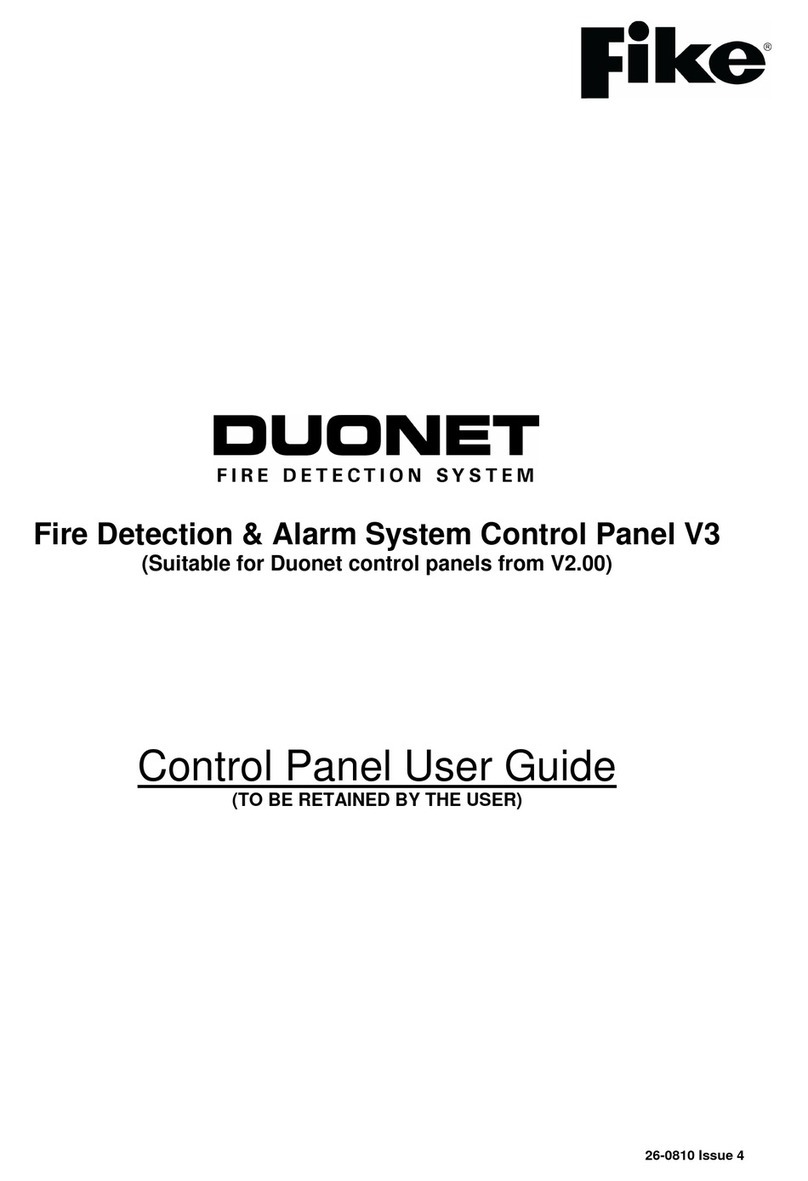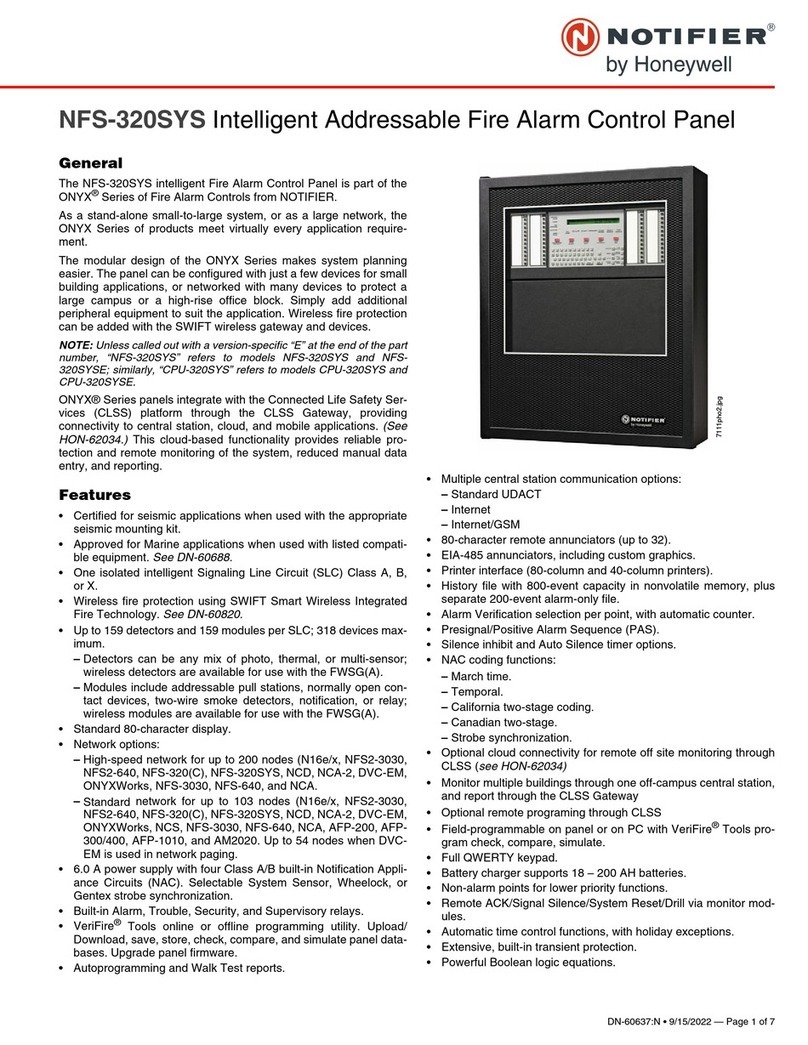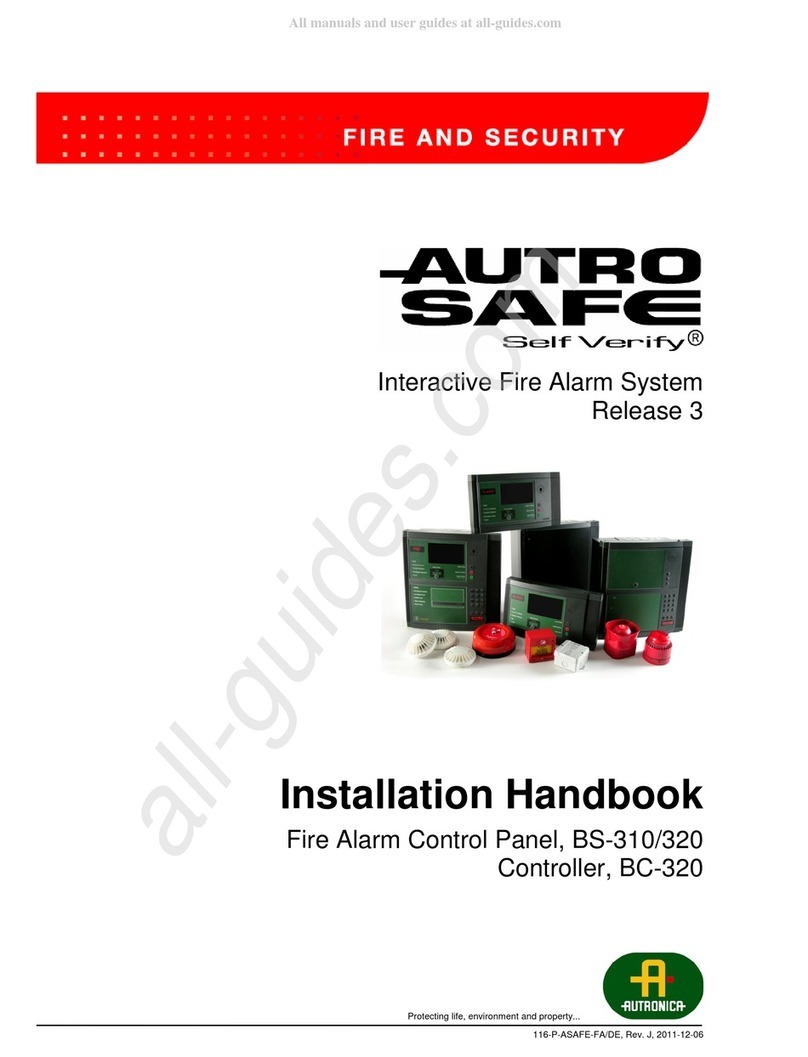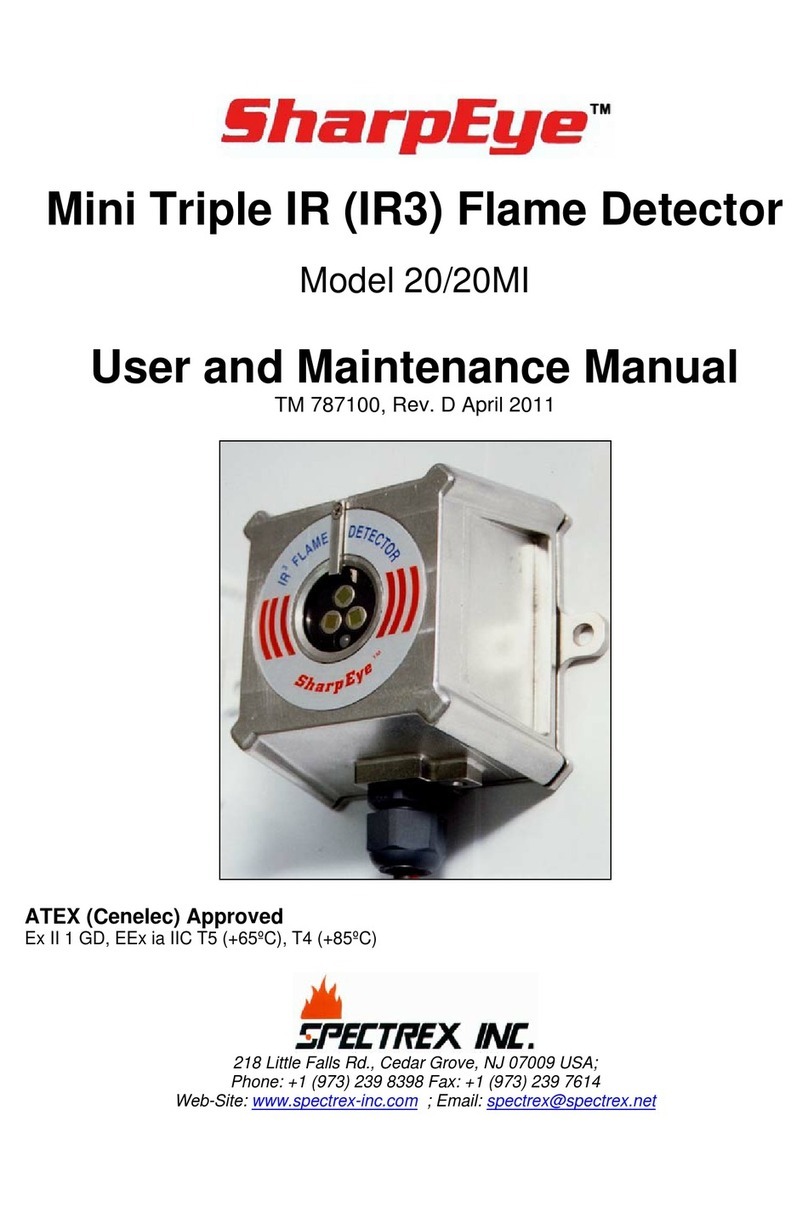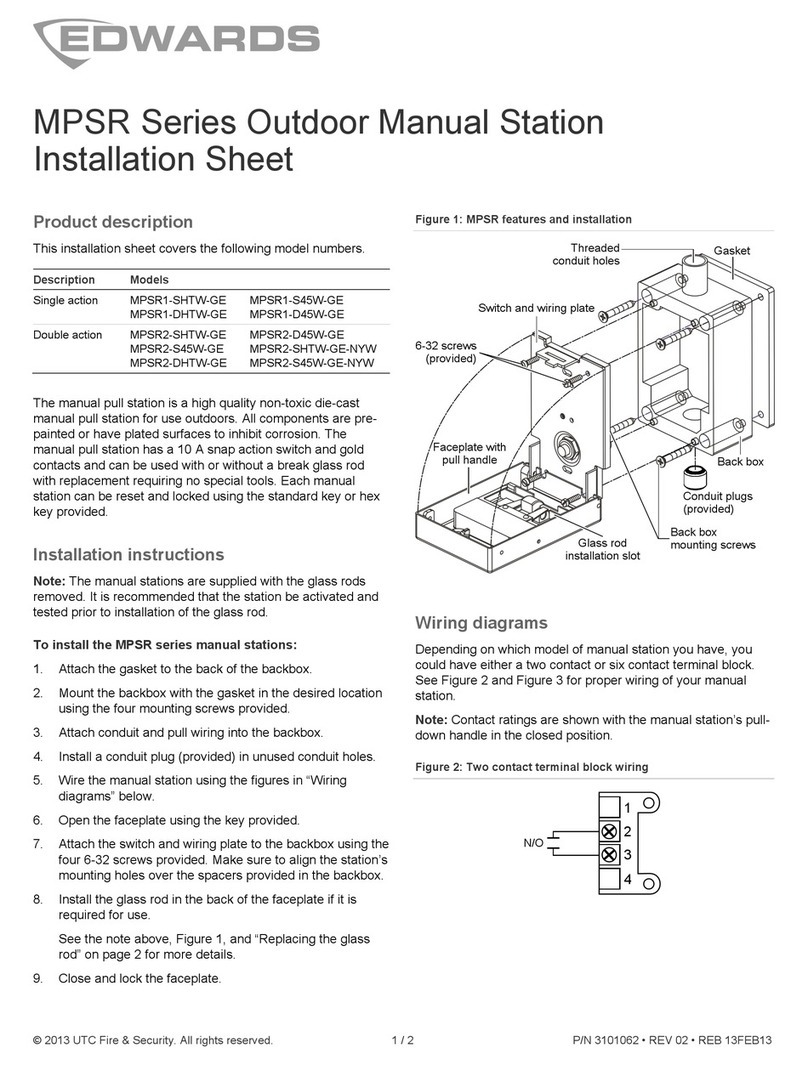Fike CIE-A-200 User manual

CIE-A-200 User Manual
Fire Detecon & Alarm System Control Panel
(Suitable for control panels from V1.00)
26-1780 Issue 1

CIE-A-200 Control Panel User Guide
2
Fike’s policy is one of connual improvement and the right to change a specicaon at any me without
noce is reserved. Whilst every care has been taken to ensure that the contents of this document are correct
at me of publicaon, Fike shall be under no liability whatsoever in respect of such contents.
Due to the complexity and inherent importance of a life risk type system, training on this equipment is
essenal and commissioning should only be carried out by competent persons.
Fike cannot guarantee the operaon o f any equipment unless a ll documented instrucons are complied
with, without variation.
© 2020 Fike Safety Technology Ltd. All rights reserved. Document revised November 2020.

CIE-A-200 Control Panel User Guide
3
Contents
Introducon........................................................................................................................... 4
Purpose of the Guide ................................................................................................................4
Denions ................................................................................................................................4
Understanding the Equipment .................................................................................................5
System Conguraon ...............................................................................................................6
What to do if . . . .......................................................................................................................6
User Responsibilies.............................................................................................................. 7
Introducon ..............................................................................................................................7
Roune Tesng .........................................................................................................................7
General Operaon ................................................................................................................. 9
Fire Alarm Controls ...................................................................................................................10
System Controls ........................................................................................................................10
Access Levels and Codes ...........................................................................................................11
Fire Alarm .................................................................................................................................11
On Hearing the Alarm ...............................................................................................................11
Accessing the Controls .............................................................................................................11
Silencing the Alarms .................................................................................................................12
Reseng the System ................................................................................................................12
Sounding the Alarms ................................................................................................................12
Exing Access Level 1 (User) or Access Level 2 (Supervisor) ....................................................12
LED Indicaon ...........................................................................................................................13
Troubleshoong ........................................................................................................................14
Advanced Operaon .............................................................................................................. 15
Access Level 0 (Normal): Controls Enabled LED o ..................................................................15
Access Level 1 (User): Controls Enabled LED on .......................................................................15
Access Level 2 (Supervisor): Controls Enabled LED ashing slowly ..........................................16
Log Book ................................................................................................................................ 21
Event Log ..................................................................................................................................21
Important Notes .......................................................................................................................26
FIRE ALARM SYSTEM NOTICE.................................................................................................. 27
To Enable the Control Panel Keys .............................................................................................27
To Manually Operate the Fire Alarm Sounders .........................................................................27
Following a Fire Alarm Operaon .............................................................................................27
Following a Fault Condion ......................................................................................................27
FIRE ALARM USER NOTICE...................................................................................................... 28
Operaon .................................................................................................................................28
Acon Required ........................................................................................................................28
Further Informaon ..................................................................................................................28
Installaon Details ................................................................................................................. 29
Equipment ................................................................................................................................29
In an emergency call: ................................................................................................................29

CIE-A-200 Control Panel User Guide
4
Introducon
Purpose of the Guide
This guide is provided to enable the person responsible for the re alarm system (see Denions) to
operate the system, undertake their responsibilies with regard to tesng and maintenance of the
system, and to record events and service/maintenance visits.
This is a generic document and therefore refers to the system components in general terms only. The
details of the installed system should be recorded in the space provided within this guide, and for
further reference, the record drawings (if applicable) should be consulted.
The responsible person, and any other sta who may be required to operate the system in an emergency,
should read and understand the basic operang instrucons before an emergency situaon occurs.
Denions
Responsible person:
The person having control of the premises, whether as an occupier or otherwise, or any person
delegated by the person having control of the premises to be responsible for the re alarm system
and the re procedures.
Competent Person:
A person competent to perform a dened task:
Normally a competent person will be an employee of the manufacturer, installer or servicing contractor,
or servicing contractor, or a member of the end user’s sta who has received suitable training from
the manufacturer, supplier or installer.

CIE-A-200 Control Panel User Guide
5
Understanding the Equipment
What is CIE-A-200 ?
The CIE-A-200 system is an addressable intelligent detector system, with many advantages over
tradional addressable analogue sensor systems. In order to understand the benets, let us look
more closely at the terms Fire Detector and Fire Sensor. These terms are oen used interchangeably
but actually have quite dierent meanings. A re detector is the device (component as dened in
EN54) which automacally detects a re. In the majority of addressable re detecon systems, the
re devices are in fact re sensors which only transfer data relang to smoke and heat levels to the
control panel, and the re decision is made by the panel.
Nearly all current addressable systems are Addressable Analogue Detector Systems where the control
panel connually scans the re sensors, processes the returned data, and makes decisions about res
and faults.
The CIE-A-200 system is dened as an Addressable Intelligent Detector System or an Addressable
Fire Detecon and Alarm System with Independent Distributed Intelligence. Distributed intelligence
signies that the signal processing is spread throughout the system, in order that the decisions
about res and faults are taken within the detector itself. The detector is capable of being remotely
programmed for dierent modes of detecon.
Thus the CIE-A-200 system is an analogue addressable system, but with the processing power
distributed across the enre system. This dramacally reduces the complexity of the control panel
and the data trac, and improves the eciency of the system.
The system addressing is carried out automacally upon inialisaon from the control panel, and
does not need to be programmed manually at each device.
Each device has a built in isolator. When the loop is inialising the panel addresses each device on the
loop starng with the rst device connected to Loop End 1, when the rst device has been addressed
it will close its isolator and allow the second device to be addressed. This process will carry on and
nish with the last device connected to Loop End 2. When the last device is addressed and closes its
isolator power is applied to Loop End 2, the panel detects this and reports Loop Complete.
The panel will then check for addressable spurs on each device. Addressable spurs are no longer used;
this operaon is only to allow for backward compability where this panel may be used to replace an
old system which is using addressable spurs.

CIE-A-200 Control Panel User Guide
6
System Conguraon
The detectors and call points are arranged in zones to enable the locaon of a re alarm to be idened.
The number of zones depends on the size and the layout of the premises, and is limited to 32 zones
per control panel (there may be more than one). There should be a chart or drawing provided with the
system indicang the area and layout of the zones – ensure that you are familiar with the zone layout
so that appropriate acon can be taken in the event of a re alarm.
The control panel display may also give you a zone number, a device descripon, a device number and
a device type; indicang the exact locaon of the device which has operated.
The system may be interfaced with the building services, e.g., the air condioning may be shut down
when the alarm sounds. Make sure that you know what happens when the re alarm operates as this
can aect roune system tesng.
The system is powered from the mains supply and incorporates a standby baery which automacally
maintains the system in operaon for a me of at least 48 hours in the event of a mains supply failure.
What to do if . . .
The re alarm sounds;
CARRY OUT THE PRESCRIBED FIRE DRILL
When it is safe to do so silence the alarms and reset the system, having rst established the cause of
the alarm (refer to Operaon).
The panel buzzer sounds;
If the panel buzzer sounds without the alarm sounders operang it is likely to be a fault or other
abnormal condion.
Make a note of all illuminated LEDs and displayed messages, record the me that the condion
occurred (if known), and other events within the building, eg., power failure, contractors working,
etc. (refer to Troubleshoong). Call the service company with as much informaon as possible.

CIE-A-200 Control Panel User Guide
7
User Responsibilies
Introducon
The responsible person is required under BS5839 to undertake certain tasks with respect to the tesng
and maintenance of the re alarm system. The responsible person should also ensure that wrien
procedures are in place for the acons to be taken by the occupants in a re condion, and that sta
required to operate the system have received adequate training. In a small building the re procedures
can be quite simple, but when larger premises are involved the re procedures can become more
complex and may involve the appointment of re wardens, reporng procedures, various assembly
points, etc.
The responsible person is also required to liaise with the building maintenance personnel to ensure
that their work does not impair or otherwise aect the operaon of the re alarm system, and to
ensure that a clear space is maintained in the vicinity of detectors, and call points remain unobstructed
and conspicuous.
Roune Tesng
The responsible person should also ensure that the following roune tesng is carried out. If there
is a link to a remote monitoring centre it will be necessary to advise the centre prior to a test, or use
the control panel facilies to isolate the link. On larger systems it may be necessary to isolate building
services interfaces to avoid disrupon to the occupants. In any case the panel should provide audible
and visual indicaon that parts of the system are disabled.
Daily
Check that the panel indicates normal operaon and that any fault is recorded. Also check that the
recorded faults have been dealt with.
Weekly
At least one detector or call point should be operated to test the ability of the control equipment to
receive a signal and sound the alarm.
In pracce it is far easier for the user to acvate a manual call point, rather than a detector which
requires special equipment. A dierent device should be tested each me if possible, such that each
zone on the system is tested at least once in a 13 week period.
The results should be recorded in the log book.

CIE-A-200 Control Panel User Guide
8
Annual
‘The responsible person should ensure that every 12 months the following checks are carried out by
a competent person’
In other words the system should be checked by a re alarm service organisaon. This may be the
system installer or an approved maintenance company, and is normally arranged via a maintenance
agreement which species the number of visits and the level of service. The agreement should also
cover non-maintenance visits, e.g. call outs to aend faults, etc.
The standard species a number of maintenance tasks which include a visual inspecon of the
installaon to ensure that there are no alteraons or obstrucons which could aect the operaon of
the system, and funconal checks to conrm the operaon of the system.
Every device on the system should be tested within a 12 month period. Dierent service organisaons
may undertake device tesng on the same visit, ie. One major service and three minor service visits
per year, or they may test a percentage of the devices on each visit so that they are all tested within
the 12 month period.
Any defects should be recorded in the log book and reported to the responsible person. A cercate
of tesng should also be completed and given to the responsible person.
Acon by the user aer a re
Advise the servicing company and arrange for the system to be tested by them. A cercate of tesng
should be issued to conrm the system operaon following the inspecon and any remedial work that
is necessary.
Acon by the user aer any false alarm
The user can assist the servicing company in the idencaon of false alarms by observing the
following:
• Always make a note of all illuminated indicators and messages displayed at the control panel.
• Try and idenfy the acvated device, i.e. Do not reset the system unl the area of the incident has
been inspected.
• Record any other incidents occurring at the same me which could aect the system, e.g. power
supply failure, building works, etc.
The service organisaon will be more likely to trace the false alarm if the above informaon is available.
Acon by the user following a fault
When a fault is reported by the control panel, the user should note all illuminated LEDs and messages
displayed, and the circumstances at the me the fault occurred, and report to the servicing company.
The service company will be able to advise if the system is sll able to respond to a re alarm or whether
extra vigilance should be observed unl the fault is reced. Faults should not be le unreported.

CIE-A-200 Control Panel User Guide
9
General Operaon
Normal: Controls Enabled LED o
At Access Level 0 (Normal), the main Fire Alarm Controls are disabled and the Controls Enabled LED
is switched o – see Fire Alarm Controls.
Control Panel Front
General Indicaon & System Indicaon LEDs
Control Panel
Informaon
Window
Fire Alarm Controls
Zonal
Indicaon
LEDs
System Controls

CIE-A-200 Control Panel User Guide
10
Fire Alarm Controls
The main Fire Alarm Controls may be enabled by turning the key switch to the controls enabled
posion, or by entering a valid Access code.
System Controls
A context-driven highlighted-selecon menu system is used to navigate the menu system, automacally
prompng you with the relevant opons for your Access Level and system status.
The menus may be navigated in one of two ways as required:
1. Use the UP / DOWN keys to move the highlighted selecon and press ENTER to select the chosen
one.
2. Enter the desired opon number and press ENTER to select it.
Press the Esc key to exit to the previous menu.
1. View Current Events
2. Test Controls & Display
1. View Current EventsSupervisor
User
2. Test Modes
3. View Logs
4. Delay On/O
5. Enable/Disable
6. Time & Date Sengs
7. Find Device
8. Diagnoscs
9. Access Levels

CIE-A-200 Control Panel User Guide
11
Access Levels and Codes
The menu system is divided into four access levels in order to restrict access to those who require it.
For simple indicaon the status of the Controls Enabled light will show the level selected as follows:
Access Level Descripon Shi LED Key Operaon Default Code
0 – NORM Normal OFF NO N/A
1 – USER User ON YES 8737
2 – SUPR Supervisor SLOW FLASH NO 7877
Access to the menu system requires either the operaon of the enable controls key to Access Level 1
(User), or the correct entry of the relevant code for access to all other levels, in order to protect against
unauthorised access to the system. The codes may be changed using the relevant panel menu or via
the CIE-A-200 OSP soware. CIE-A-200 OSP soware is only operaonal in engineer level, details of
which are given in the CIE-A-200 Engineer and Commissioning Manual.
A valid access level code must be entered in order to access any of the menus.
Fire Alarm
When the panel enters the re state, the alarms will sound, the re LEDs will illuminate, the buzzer
will pulse quickly and the display will show the locaon and type of alarm.
On Hearing the Alarm
The responsible person should have already prepared wrien procedures for the acon to be taken in
the event of a re alarm. When the alarm sounds these procedures should be implemented.
Accessing the Controls
The user controls are accessed from Access Level 2A (User), or Access Level 2B (Supervisor) which is
reached as follows:
1. Turn the key,
Or
Enter your 4-digit Access Level 1
(User) or Access Level 2 (Supervisor)
code.
The ‘Enable Controls’ light will light up
connuously, and USER is displayed in the top
right hand corner of the LCD display screen.
The buzzer will be heard on each key press,
and when successfully entered the ‘Enable
Controls’ light will light up connuously, and
USER or SUPR is displayed in the top right hand
corner.
You are now in Access Level 1 (User) or Access
Level 2 (Supervisor) and may proceed to silence
and reset the system.

CIE-A-200 Control Panel User Guide
12
Silencing the Alarms
When the re procedures have been carried out and it is safe to silence the alarm, proceed as follows.
Reseng the System
Before aempng to reset the system, the cause of the alarm should be established and cleared.
Note: if the panel does not reset or a fault condion is displayed, call your maintenance engineer
immediately.
Sounding the Alarms
To sound the alarms at any me aer they have been silenced, proceed as follows:
Exing Access Level 1 (User) or Access Level 2 (Supervisor)
In order to prevent unauthorised access to the system, return to Access Level 0 (Normal). However, if
le untouched the display will me out aer a short while and return automacally to Access Level 0
(Normal).
1. Enable the controls and then press
’SILENCE ALARMS’
1. Enable the controls and then press
’SOUND ALARMS’
Turn the key OFF if it is turned on.
Or;
Press ‘ESC’ unl the system shows NORM in the
top right hand corner. The ‘Enable Controls light
will switch o and the controls are disabled.
1. Enable the controls and then press
’RESET SYSTEM’
The alarm sounders should silence, but the
buzzer and the re indicaon lights should
remain.
The alarm sounders will acvate. The buzzer
will also switch on
The ‘Enable Controls light will switch o and
the controls are disabled.
NORM is displayed in the top right hand corner.
The buzzer and the re indicaon lights should
switch o.
However, if any alarm condion sll exists, e.g.
a manual call point requires reseng, then the
panel will revert to the re state unl the cause
for the alarm is removed.

CIE-A-200 Control Panel User Guide
13
LED Indicaon
The operaon of the LED indicaon on the front of the control panel is
described below. The LED indicaon on the panel can also be conrmed
by checking the message displayed in the panel informaon screen or
by accessing the relevant event log from the panel menu
Descripon Colour State Reason
POWER Green Connuous This indicates that power is being supplied to the control panel from either the
230V AC mains supply, or the standby baeries.
TEST Yellow Connuous This indicates that a test roune is in place. End all tests to clear.
DELAY Yellow Connuous An acon has been started which ulises a programmed delay.
FAULT Yellow Connuous The control panel is in the fault state. Other indicators will show the origin.
SYSTEM FAULT Yellow Connuous The system Fault LED indicates the presence of a processor or a checksum error.
Power the system down to clear, reprogram all sengs and test the system.
POWER FAULT Yellow Connuous The mains supply or standby baery supply has failed (check the fuses, baery and
the 230V AC supply.
SOUNDER FAULT Yellow Connuous A fault condion is present on a monitored sounder circuit or on the addressable
device loop sounders.
DISABLED Yellow Connuous This indicates that a disablement acon is in place. Enable all devices / acons to
clear.
SOUNDER DISABLED Yellow Connuous This indicates that a sounder disablement acon is in place. Enable all devices /
acons to clear.
FIRE OUTPUT FAULT Yellow Connuous A fault condion is present on a monitored Fire Output circuit or on the addressable
device loop outputs.
FIRE OUTPUT DISABLED Yellow Connuous This indicates that a Fire Output disablement acon is in place. Enable all Fire
Outputs to clear.
FIRE OUTPUT DISABLED Green Connuous This indicates that a Fire Output disablement acon is in place. Enable all Fire O
utputs to clear.
FAULT OUTPUT DISABLED Yellow Connuous This indicates that a Fault Output disablement acon is in place. Enable all fault
outputs to clear
ALARM CONFIRMATION Yellow Connuous A smoke detector is in the alarm conrmaon state, awaing conrmaon or reset
FIRE Red Connuous The control panel is in the re state. Other indicators will show the origin.
ZONE 1-32 Red Connuous
The control panel is in the re state. The zone LED will illuminate to indicate the
zone where the re as occurred.
More zone LEDs may be illuminated if res have been detected in more than one
zone.

CIE-A-200 Control Panel User Guide
14
Troubleshoong
Problem Possible Cause Remedial Acon
Unable to silence alarms Panel not in Access Level 1 (User)
or Access Level 2 (Supervisor)
Enter Access Level 1 (User) or
Access Level 2 (Supervisor) - see
secon on operaon.
Unable to reset system
Alarms not silenced Silence alarms before aempng
to reset the system.
Panel not in Access Level 1 (User)
or Access Level 2 (Supervisor)
Enter Access Level 1 (User) or
Access Level 2 (Supervisor) - see
secon on operaon.
Alarm condion sll present Remove cause of alarm, eg. reset
call point element with key
Panel buzzer sounding,
FAULT LED lit Fault or abnormal condion
Note all illuminated LEDs and
displayed messages.
Call engineer.
Panel buzzer sounding,
POWER FAULT LED ashing,
‘Mains supply failed’ displayed
Mains supply failure
Wait unl mains supply is
restored – if panel does not revert
to normal operaon call engineer.
Panel buzzer sounding,
SYSTEM FAULT LED lit Control panel fault Call engineer immediately.
Any other fault or abnormal
behaviour Various
Note all illuminated LEDs and
displayed messages.
Call engineer.
ALARM SOUNDING Yellow Connuous The alarm sounders have been acvated from the Sound Alarms buon on the panel.
ALARM SILENCED Yellow Connuous The alarms have been silenced whilst operang and will stay silenced unl another
re or relevant acon occurs.
BUZZER SILENCED Yellow Connuous The control panel buzzer has been silenced whilst operang and will stay silenced
unl another fault or relevant acon occurs.

CIE-A-200 Control Panel User Guide
15
Advanced Operaon
Access Level 0 (Normal): Controls Enabled LED o
At Access Level 0 (Normal), the main Fire Alarm Controls are disabled and the Controls Enabled LED
is switched o.
A valid access level code must be entered or the key switch must be used in order access any of the
menus.
Delay Override
To comply with EN54-2 Clause 7.11.1d, a manual call point (MCP) should be located next to the CIE to
override the delayed output by a manual operaon.
Access Level 1 (User): Controls Enabled LED on
At Access Level 1 (User), the main Fire Alarm Controls are enabled, and the following System Controls
are accessible:
1. View Current Events
Current events show the current state of the system and can be viewed in the current events menus.
2. Test Modes
The Test Modes funcon causes the panel LEDs to illuminate, the LCD screen to blacken, the panel
buzzer to sound and key pad to be tested in order to verify their correct operaon.
Press the Esc key to exit to the previous menu.

CIE-A-200 Control Panel User Guide
16
Access Level 2 (Supervisor - 7877): Controls Enabled LED ashing slowly
At Access Level 2 (Supervisor), the main Fire Alarm Controls are enabled, and the following System
Controls are accessible:

CIE-A-200 Control Panel User Guide
17
1. View Current Events – Same as USER access page 17
2. Test Modes
Test Modes → Test Controls & Display
The Test Modes funcon causes the panel LEDs to illuminate, the LCD screen to blacken, the panel
buzzer to sound and the keypad to be tested in order to verify their correct operaon.
Test Modes → Silent Test Mode
The Silent Test funcon allows the selecon of one or more detecon-zones to operate in a ‘silent
one-man walk test mode’. On triggering a device the device LED operates and the event is recorded
into the event log as a test acvaon, but the sounder does not sound and the control panel does not
show an alarm. Aer approximately 5 seconds the system will reset the device, and another device
may be tested. The control panel event log will indicate that a test mode has been selected.
Test Modes → Local Audible Test
The Local Audible Test funcon allows the selecon of one or more detecon-zones to operate in
a ‘one-man walk test mode with local sound’. On triggering a device the device LED operates, the
sounder within that device operates and the event is recorded into the event log as a test acvaon,
but the control panel does not show an alarm. Aer approximately 5 seconds the system will reset
the device, and another may be tested. The control panel event log will indicate that a test mode has
been selected.
Test Modes → System Test
The System Test funcon allows the enre system to operate in a simple one-man walk test mode. On
triggering a device the device LED operates and the event is recorded in the event log , all the assigned
sounders operate for 10 seconds and the control panel indicates an alarm. Aer approximately 10
second the system will reset the device, and another may be tested. The control panel event log will
indicate that a test mode has been selected.
Please note, with the system test mode, only the sounders assigned to operate from that device will
sound, and any delays will sll be present. ie. if a delay of 2 minutes is present, the system will have
been reset before the sounders acvate.
Please note, with the system test mode, only the sounders assigned to operate from that device will
sound, and any delays will sll be present. ie. if a delay of 2 minutes is present, the system will have
been reset before the sounders acvate.
3. View Event Logs
The all event log keeps up to 1000 historic events. Opons 2 to 6 sort the all events log into re, fault,
disablements, panel events & test events. This makes it easier to nd specic types of event without
having to look through the whole event log.
View Event Logs → All Event Log
The All Event Log will display all events. These are displayed in text format and may be scrolled through
by pressing the UP and DOWN keys.

CIE-A-200 Control Panel User Guide
18
4. Delay Override
The Delay Override funcon overrides any programmed delays. Reset System will automacally re-
enable the delay.
To comply with EN54-2 Clause 7.11.1d, a non-delayed manual call point (MCP) should be located next
to the CIE to override the delayed output by a manual operaon.
5. Enable / Disable
Inputs → Detecon Zone
This funcon allows the disablement or enablement of a detecon-zone. Thus, all the input devices
(Manual Call Points, detectors and inputs) within that detecon-zone will be disabled. The control
panel will indicate that disablements are present, a disablement event will be recorded in the log,
the device LED will sll operate when acvated and an event will be recorded in the log, but no
programmed acons will occur. The sounder within the device will sll operate if triggered from
elsewhere on the system.
Inputs → Device
This funcon allows the disablement or enablement of an individual device. The control panel will
indicate that disablements are present, a disablement event will be recorded in the log, the device
LED will sll operate when acvated and an event will be recorded in the log, but no programmed
acons will occur. The sounder within the device will sll operate if triggered from elsewhere on the
system.
Inputs → All Detecon Zone
This funcon allows the disablement or enablement of all detecon-zones. Thus, all the input devices
(Manual Call Points, detectors and inputs) will be disabled. The control panel will indicate that
disablements are present, a disablement event will be recorded in the log, the device LED will sll
operate when acvated and an event will be recorded in the log, but no programmed acons will
occur. The sounder within the device will sll operate if triggered from elsewhere on the system.
Inputs → All Devices
This funcon allows the disablement or enablement of all devices. Thus, all the input devices (Manual
Call Points, detectors and inputs) will be disabled. The control panel will indicate that disablements
are present, a disablement event will be recorded in the log, the device LED will sll operate when
acvated and an event will be recorded in the log, but no programmed acons will occur. The sounder
within the device will sll operate if triggered from elsewhere on the system.
Outputs → Sounders
This funcon allows the global disablement or enablement of all the sounders on the system. The
control panel will indicate that disablements are present and a disablement event will be recorded in
the log.

CIE-A-200 Control Panel User Guide
19
Outputs → Fire Outputs
This funcon allows the global disablement or enablement of all re outputs on the system. The
control panel will indicate that disablements are present and a disablement event will be recorded in
the log.
Outputs → Fault Outputs
This funcon allows the global disablement or enablement of all fault outputs on the system. The
control panel will indicate that disablements are present and a disablement event will be recorded in
the log.
Group Disablement
This funcon allows the disablement or enablement of the group. The group is xed and will disable all
Sounders, Fire outputs & Fault outputs. The control panel will indicate that disablements are present
and a disablement event will be recorded in the log.
6. Set Time & Date
Set Time & Date.
This allows the me and date to be adjusted.
DST Sengs.
This allows the Daylight Saving Time to be adjusted.
7. Find Device
This funcon allows the user to switch on the LED and sounder (if they are present) at any device on
the loop in order to aid in locang its posion. It cannot be used to turn on the LED of I/O Modules,
since this would also turn on the output which would not usually be desirable.
Up, Down and Esc opons allow the adjacent devices to be located, and the test to be ended.
8. Diagnoscs
There are four types of diagnoscs on the Single Loop Panel, a Loop diagnoscs, a PSU diagnoscs,
an LED diagnoscs & Peripheral Bus diagnoscs. All four come out of the User USB port on the back
board. The LED diagnoscs will send the CIE LED status to the PC based diagnosc soware.
Diagnoscs → Loop Diagnoscs
This turns the loop diagnoscs on or o. This must be set to on for the PC based diagnosc soware
to get data from the loop.
Diagnoscs → LED Diagnoscs
This turns the LED diagnoscs on or o. This must be set to on for the CIE LED status data to be sent
to the PC based diagnosc soware.

CIE-A-200 Control Panel User Guide
20
Diagnoscs → PSU Diagnoscs
This turns the PSU diagnoscs on or o. This must be set to on for the PC based diagnosc soware
to get data from the PSU.
The PSU Informaon screen will display PSU status on the Panel screen. The following informaon will
be displayed:
• Charger State Normal
Charger Fault
Baery Internal Resistance Fault
• PCB Temperature Normal
Low Temperature
High Temperature
• Baery Supply Normal
Low Voltage
Lowest Voltage
Over Voltage
• Baery Temperature Normal
Low Temperature
High Temperature
• Mains Supply Normal
Low Voltage
Over Voltage
• Earth Fault Voltage The normal voltage between 0V and Earth SCRN is 1.7V. The
panel will display an earth fault if this voltage is below 1V or
above 2.5V. The panel can detect a leakage between 0V to
Earth and between +Ve to Earth.
Diagnoscs → Peripheral Bus Diagnoscs
This shows what RDUs are programed in the OSP and what is on the Bus with error checking.
Diagnoscs → USB DIAG RESET
This resets the USB port for OSP programming.
9. Enter Access Code
This allows the Engineer code to be entered to access the (ENGR) Engineer access level.
Other manuals for CIE-A-200
2
Table of contents
Other Fike Fire Alarm manuals
Popular Fire Alarm manuals by other brands

Pittway
Pittway System Sensor V400R Installation and maintenance instructions

Autronica
Autronica Autroprime Operator's handbook
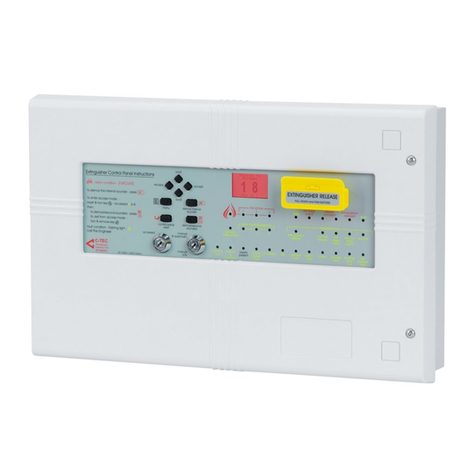
C-TEC
C-TEC EP203 Installation and maintenance manual
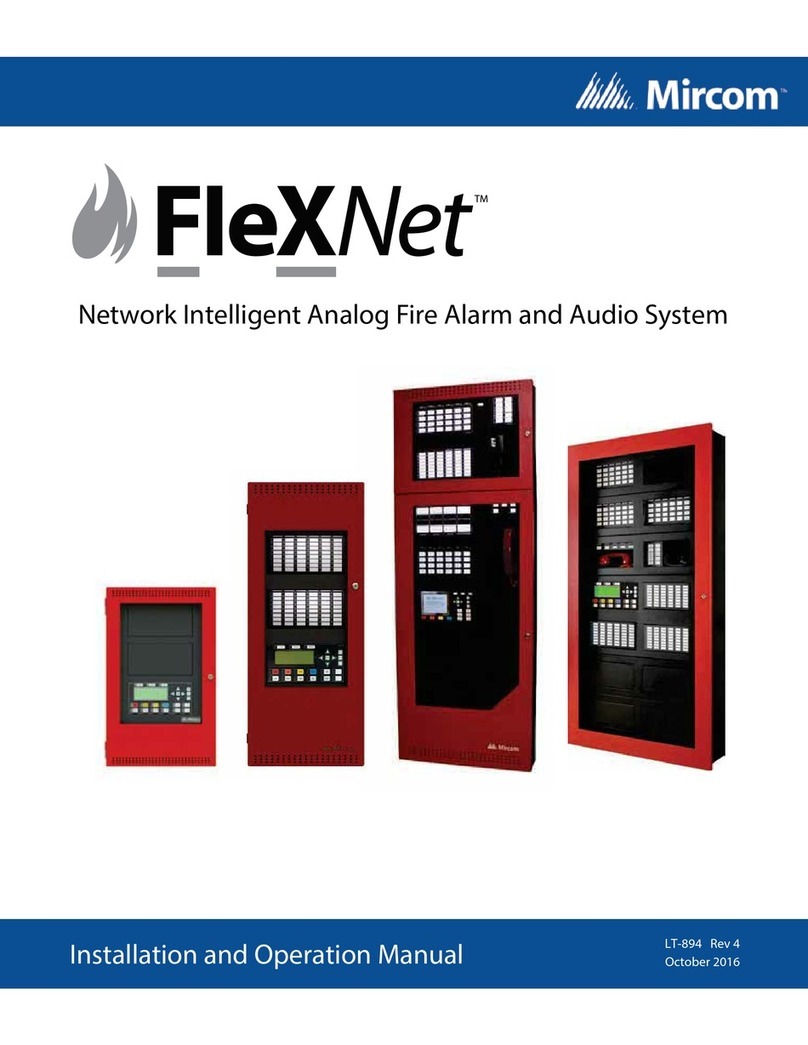
Mircom
Mircom FleXNet FNC-2000 Installation and operation manual
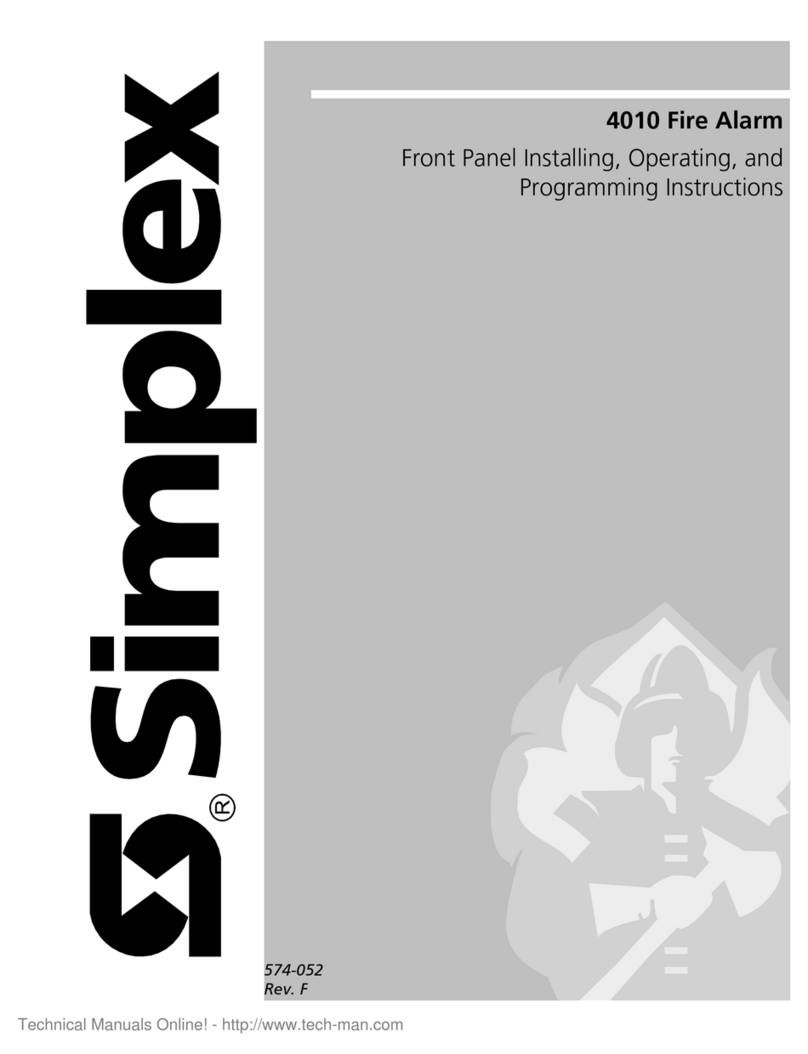
Simplex
Simplex 4010 Installing and operating insructions

Bosch
Bosch FMC-420RW-HSRRD installation guide

Teletek electronics
Teletek electronics SensoIRIS WSST Installation instruction
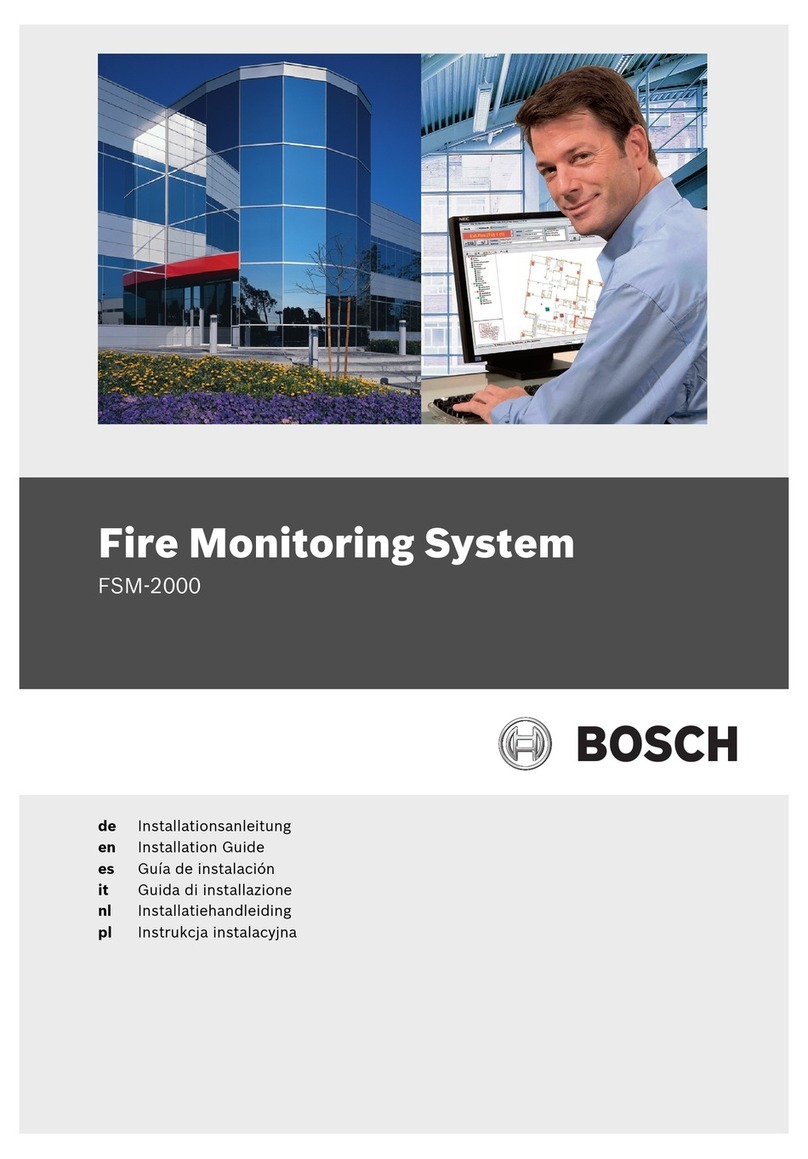
Bosch
Bosch FSM-2000 installation guide

Polon-Alfa
Polon-Alfa POLON 6000 manual

Teknim
Teknim TFS-3191 Installation & operating guide
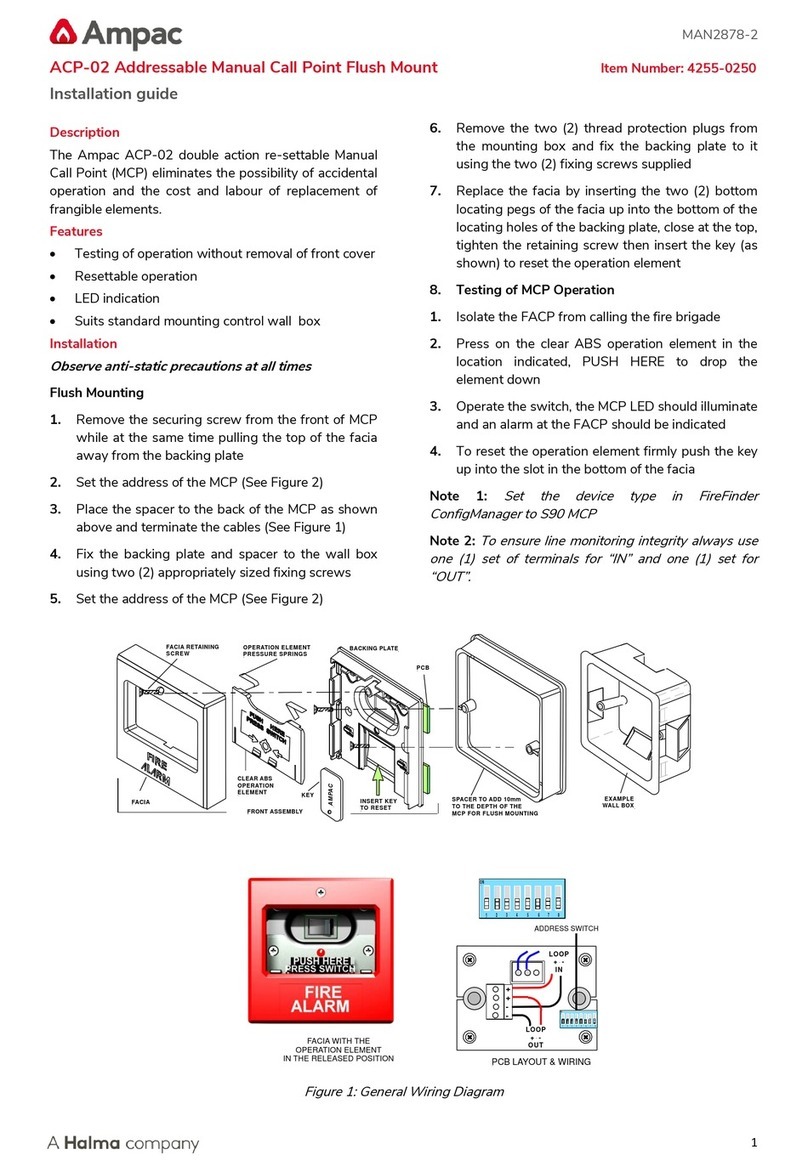
Ampac
Ampac ACP-02 installation guide
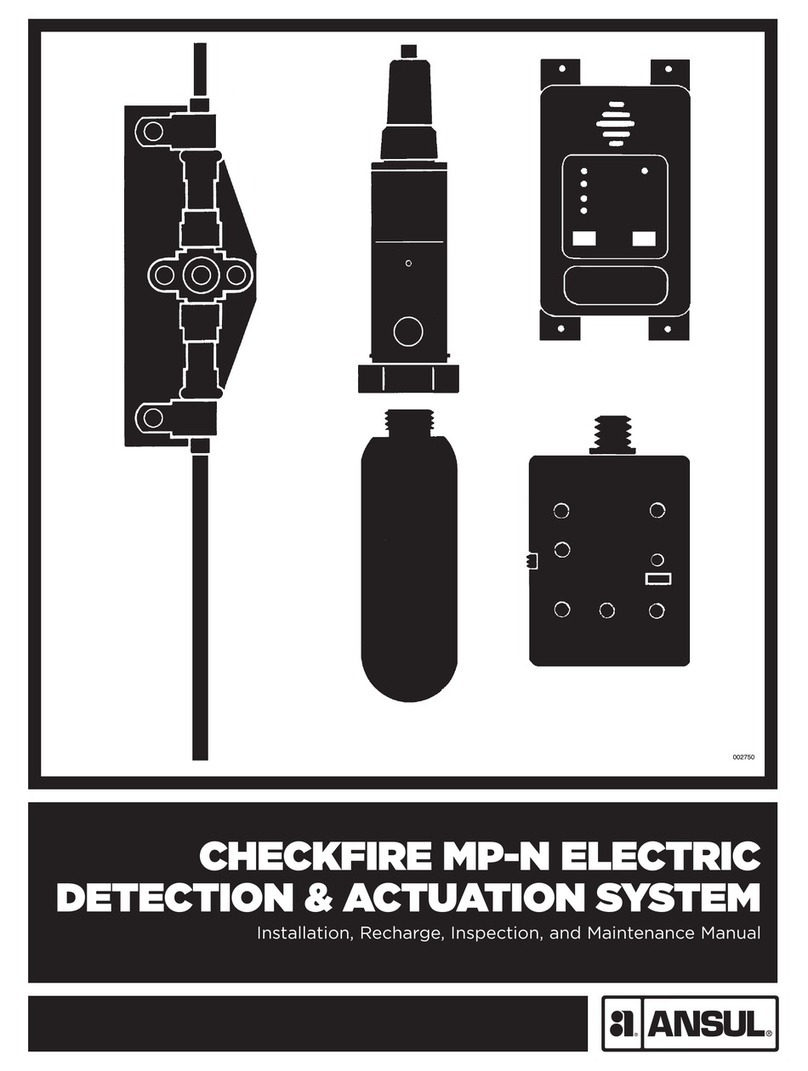
Ansul
Ansul Checkfire MP-N Installation, Recharge, Inspection and Maintenance Manual

